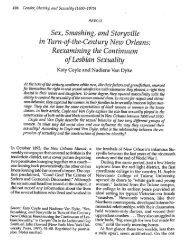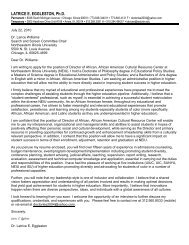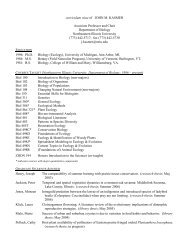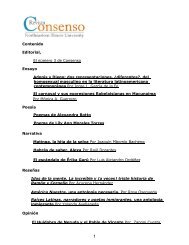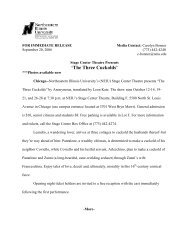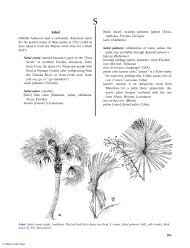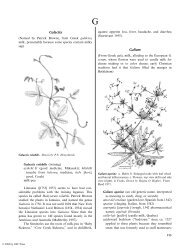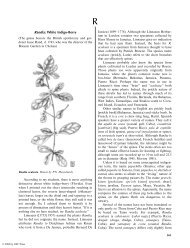Herba Cana - Northeastern Illinois University
Herba Cana - Northeastern Illinois University
Herba Cana - Northeastern Illinois University
Create successful ePaper yourself
Turn your PDF publications into a flip-book with our unique Google optimized e-Paper software.
© 2004 by CRC Press<br />
The Ethnobotany 481<br />
ifá imittó (ifá, dog,im, its, ittó, tree, Koasati)<br />
ingtha hazi itai (ghost grapes; hazi, grapes,<br />
Omaha-Ponca)<br />
manido’bima’kwud (manido, spirit, Ojibwa)<br />
omakaski’bag (toad weed, Potawatomi)<br />
sa-tai-al-go (paint berries, Kiowa)<br />
vfala omat [afala oma] (vfala, poison ivy, omat,<br />
like, Creek)<br />
vigne-vierge (virgin vine, Quebec); Virginia [Virginian]<br />
creeper (‘‘creeper’’ is another word for<br />
climber or twiner)<br />
woodbine [woodbind, wild wood-vine] (originally<br />
a European term for Convolvulus and Hedera,<br />
dating to about A.D. 875, and alluding to the<br />
tendency of the climbers to wrap around others,<br />
USA)<br />
The first record of these vines in the New World is<br />
Jacques Philippe Cornutus’s Edera quinquefolia canadensis<br />
(five-leaved <strong>Cana</strong>dian ivy), published in his<br />
book <strong>Cana</strong>densium plantarum ... historia of 1635.<br />
Linnaeus knew this and several other sources. He had<br />
studied live plants at the Hortus Cliffortianus. Perhaps<br />
because he was influenced by Cornutus and others, he<br />
called the vines Hedera quinquefolia.<br />
Probably the first report of interaction of the plant<br />
and people was left by Capt. John Smith in 1624. He<br />
wrote that, in Virginia, there was a ‘‘kind of woodbind<br />
...which runnes vpon trees, twining it self like a<br />
Vine: the fruit eaten ... worketh ... in the nature of a<br />
purge.’’ In spite of Smith’s report, Yanovsky (1936)<br />
said that the fruit could be eaten raw, and the stalks<br />
were peeled and boiled for food. He reported those<br />
uses in Minnesota, Montana, and Wisconsin. One of<br />
them is wrong, and I doubt that it was Smith.<br />
Native people in the New World had long been<br />
familiar with the twiners. The plants were used by the<br />
Cherokee, Creeks, Houma, Iroquois, Jemez, Keres,<br />
Kiowa, Meskwaki, Montana tribes, Navajo, and<br />
Ojibwa (Densmore 1928, Moerman 1998). Most of<br />
these people used the plant as medicine, but they also<br />
made dye from it, and some claim to have eaten the<br />
roots. In the southeast, the Cherokee used an infusion<br />
against jaundice (Hamel and Chiltoskey 1975). The<br />
Houma used a hot decoction of stems and leaves to<br />
reduce swelling, to treat wounds, and against lockjaw<br />
(Speck 1941). The Creeks used it against venereal<br />
disease (Taylor 1940). Snow and Stans (2001) published<br />
a picture of the vine (p. 80), but gave no<br />
common name, or included it in the text. Some<br />
Seminoles still use this medicine.<br />
In Mexico, the bark has been used as an alterative,<br />
tonic, expectorant, and against dropsy; crushed leaves<br />
are a counterirritant, producing blisters when applied<br />
to the skin (Standley 1920 /1926). Early American<br />
physicians also used a tincture, which was sometimes<br />
called Decoctum ampelopsis or Infusum ampelopsis,<br />
reflecting an old scientific name, Ampelopsis quinquefolia<br />
(Millspaugh 1892). Not much seemed to be<br />
known about its chemistry in the 1890s, and the<br />
same is true today. Foster and Duke (1990) cryptically<br />
wrote, ‘‘Berries reportedly toxic,’’ although Capt. John<br />
Smith wrote the same in the 1620s. The leaves<br />
contain calcium oxylate and cause dermatitis in<br />
some people (Foster and Duke 1990, Foster and Caras<br />
1994), compounding the difficulty people have distinguishing<br />
between this and poison ivy (Toxicodendron<br />
radicans).<br />
Paspalidium<br />
(Diminutive of Paspalum, Greek paspalos, for millet;<br />
the genus was separated from Paspalum by Otto Stapf,<br />
1857 /1933)<br />
Paspalidium geminatum (twins or double) ( /P.<br />
paludivagum)<br />
akkotó:ɬ ka [akkotó:rka] (akkotorkv, usually Nelumbo,<br />
Creek; a comparison or a misuse)<br />
ciktohacî (cekto, snake, hvce, tail, Creek)<br />
Egyptian panicum (some consider the species<br />
native, like Allen 2003, while others think it<br />
was introduced from Egypt)<br />
kissimmee grass (‘‘kissimmee’’ was rendered as<br />
Cacema on the Moll Map of 1720 and Casseeme<br />
on William’s Map of 1837; the locality was not<br />
mentioned by Swanton in either 1939 or 1946;<br />
language and meaning unknown)<br />
pahitóɬ piɬ î [pahitórpirî] (pahi, grass, toɬ piɬ l, knees,<br />
because the stem is jointed, Mikasuki; this name<br />
is also used for Panicum hemitomon, which<br />
see)<br />
water panic grass (Florida)<br />
Pehr Forsska˚l called plants he found in Egypt<br />
Panicum geminatum in 1775. However, it was not until<br />
1919 that the species was transferred to Paspalidium in<br />
the Flora of Tropical Africa. Godfrey and Wooton<br />
(1979) considered the species native, while Crins<br />
(1991), Wunderlin (1998), and Diggs et al. (1999)<br />
thought it introduced. The problem is considered<br />
unsolved by Gerald Guala (personal communication,<br />
Oct. 2003).<br />
The Seminoles use a decoction of the plant to treat<br />
‘‘Snake Sickness’’ (itchy skin) (Sturtevant 1955).





